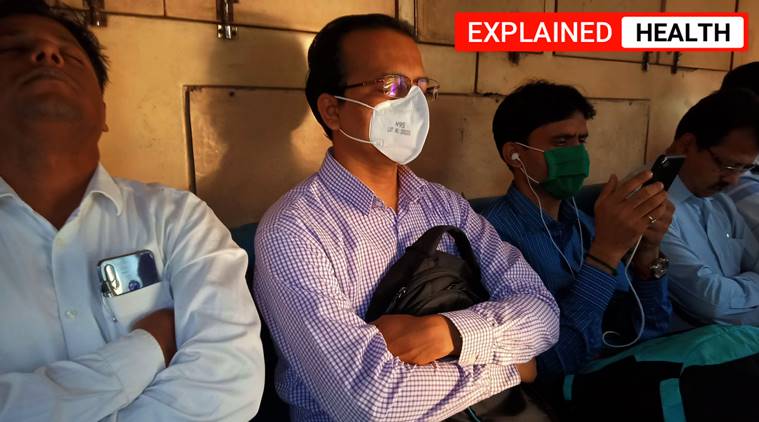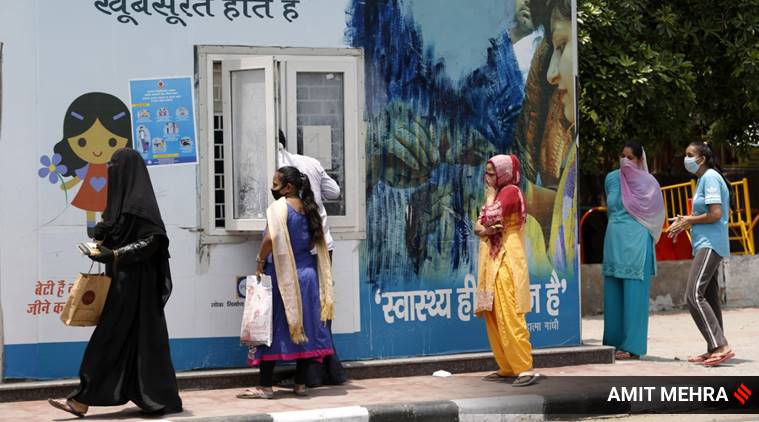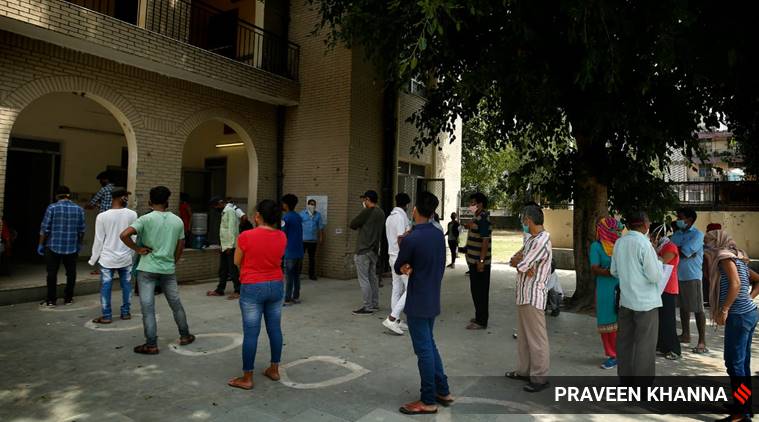
[ad_1]
 In a Mumbai local; not everyone wearing a mask. (Express photo by Amit Chakravarty)
In a Mumbai local; not everyone wearing a mask. (Express photo by Amit Chakravarty)
The New York Times reported recently that 239 scientists from 32 countries have written an open letter to the World Health Organization (WHO) that the virus causing Covid-19 can remain airborne for a period of time and thus transmit itself. The scientists have “outlined the evidence showing that smaller particles can infect people, and are calling for the agency to revise its recommendation”. The paper titled ‘It is Time to Address Airborne Transmission of Covid-19’ is likely to be published in a scientific journal next week.
What does this mean?
A respiratory infection such as Covid-19 is transmitted through droplets of different sizes. If the droplets particles are larger than 5-10 microns in diameter, they are referred to as respiratory droplets; if they are smaller than 5 microns in diameter, they are referred to as droplet nuclei. “According to current evidence, Covid-19 virus is primarily transmitted between people through respiratory droplets and contact routes,” the WHO states.
However, the letter written by the scientists suggests aerosol transmission too can happen.
In other words, the WHO’s viewpoint is that droplets containing the virus, produced during speech, coughing, sneezing etc, are larger than 5-10 microns in diameter and eventually succumb to gravity and fall to the ground after travelling less than 1 metre. The 239 scientists, on the other hand, are citing evidence that the virus can be present in droplet nuclei (less than 5 microns in diameter) that do travel distances longer than 1 metre, and can remain in the air for a longer time.
If this can be established, it will mean that the risk of transmission is higher than previously thought.
 Outside a Mohalla clinic in New Delhi
Outside a Mohalla clinic in New Delhi
Is this a new revelation?
As per the WHO, airborne transmission may be possible in specific circumstances and settings. These include settings in which procedures that generate aerosols are performed; endotracheal intubation; bronchoscopy; open suctioning; administration of nebulised treatment; manual ventilation before intubation; turning a patient to the prone position; disconnecting a patient from the ventilator; non-invasive positive-pressure ventilation; tracheostomy; and cardiopulmonary resuscitation.
Referring to the NYT report, the WHO has stated that “initial findings need to be interpreted carefully.” If the evidence being cited has to be examined, researchers will look at the specific settings in which the virus was found airborne, the duration for which the virus was found staying in the air, and, most importantly, whether the virus continues to be infectious throughout this duration.
What if the claim is established?
It means that wearing a mask becomes more important than ever. It might be possible that N-95 masks, which are used by clinicians in hospital settings, could now be recommended to prevent aerosol transmission, subject to availability, and depending on the health condition of a person.
📣 Express Explained is now on Telegram. Click here to join our channel (@ieexplained) and stay updated with the latest
 Health workers take Covid-19 samples in New Delhi. (Express Photo: Praveen Khanna)
Health workers take Covid-19 samples in New Delhi. (Express Photo: Praveen Khanna)
What is the evidence so far on the aerosol transmission?
* One of the first studies, published in Nature, was conducted in Renmin Hospital and Wuchang Fangcang Field Hospital in Wuhan. It investigated the aerodynamic nature of the virus SARS-CoV-2 by measuring its viral RNA in aerosols.
The study found that the concentration of the virus in aerosols detected in isolation wards and ventilated patient rooms was “very low”, but it was “higher in the toilet areas used by the patients”. “Levels of airborne SARS-CoV-2 RNA in the most public areas was undetectable, except in two areas that were prone to crowding,” the study stated. “Although we have not established the infectivity of the virus detected in these hospital areas, we propose that SARS-CoV-2 may have the potential to be transmitted through aerosols.”
* In April, a correspondence published on NEJM by researchers from the US National Institute of Allergy and Infectious Diseases in the United States evaluated the stability of SARS-CoV-2 (and SARS-CoV-1, which causes SARS) in aerosols and on various surfaces. It found that SARS-CoV-2 “remained viable in aerosols” throughout the duration of the experiment that lasted for three hours. “Our results indicate that aerosol and fomite transmission of SARS-CoV-2 is plausible since the virus can remain viable and infectious in aerosols for hours,” the study said.
WHO, disagreeing with the findings of NEJM article, said, “… The finding of COVID-19 virus in aerosol particles up to 3 hours does not reflect a clinical setting in which aerosol-generating procedures are performed—that is, this was an experimentally induced aerosol-generating procedure.”
* In May, the US Centers for Disease Control and Prevention (CDC), published a study titled “High SARS-CoV-2 Attack Rate Following Exposure at a Choir Practice”. The researchers, who studied “superspreading events”, found that following 2.5-hour choir practice attended by 61 persons, including a symptomatic index patient, 32 confirmed and 20 probable secondary Covid-19 cases occurred; three patients were hospitalised, and two died.
The study noted that “the act of singing” itself — might have contributed to “transmission through the emission of aerosols, which is affected by the loudness of vocalization”. “Certain persons, known as superemitters, who release more aerosol particles during speech than do their peers, might have contributed to this and previously reported COVID-19 superspreading events,” it said.
“… Aerosol emission during speech has been correlated with loudness of vocalization, and certain persons, who release an order of magnitude more particles than their peers, have been referred to as superemitters and have been hypothesized to contribute to superspeading events. Members had an intense and prolonged exposure, singing while sitting 6–10 inches from one another, possibly emitting aerosols,” it said.
📣 The Indian Express is now on Telegram. Click here to join our channel (@indianexpress) and stay updated with the latest headlines
For all the latest Explained News, download Indian Express App.
[ad_2]
Source link